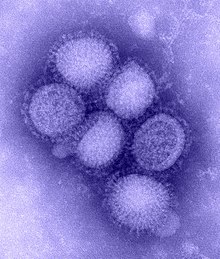
Back H1N1 Afrikaans فيروس الإنفلونزا أ H1N1 Arabic فيروس الانفلونزا H1N1 ARZ H1N1 Byelorussian Grip A Breton H1N1 Catalan Chřipkový virus A subtypu H1N1 Czech Influenza-A-Virus H1N1 German Γρίπη H1N1 Greek Influenzavirus A subtipo H1N1 Spanish
| Influenza A virus subtype H1N1 | |
|---|---|

| |
| Virus classification | |
| (unranked): | Virus |
| Realm: | Riboviria |
| Kingdom: | Orthornavirae |
| Phylum: | Negarnaviricota |
| Class: | Insthoviricetes |
| Order: | Articulavirales |
| Family: | Orthomyxoviridae |
| Genus: | Alphainfluenzavirus |
| Species: | |
| Serotype: | Influenza A virus subtype H1N1
|
| Strains | |
| Influenza (flu) |
|---|
 |
In virology, influenza A virus subtype H1N1 (A/H1N1) is a subtype of influenza A virus. Major outbreaks of H1N1 strains in humans include the 1918 Spanish flu pandemic, the 1977 Russian flu pandemic and the 2009 swine flu pandemic. It is an orthomyxovirus that contains the glycoproteins hemagglutinin (H) and neuraminidase (N), antigens whose subtypes are used to classify the strains of the virus as H1N1, H1N2 etc. Hemagglutinin causes red blood cells to clump together and binds the virus to the infected cell. Neuraminidase is a type of glycoside hydrolase enzyme which helps to move the virus particles through the infected cell and assist in budding from the host cells.[1]
Some strains of H1N1 are endemic in humans and cause a small fraction of all influenza-like illness and a small fraction of all seasonal influenza, for instance in 2004–2005.[2] Other strains of H1N1 are endemic in pigs (swine influenza) and in birds (avian influenza). Its size is 80 to 120 nm (3.1×10−6 to 4.7×10−6 in) in diameter.[3]
Genetic analyses of virus from tissue preserved medically or in permafrost suggest that modern seasonal H1N1 strains descended from the 1918 flu pandemic virus, but not conclusively so.[4][5]
- ^ Lim, Boon H.; Mahmood, Tahir A. (23 September 2011). "Influenza A H1N1 2009 (Swine Flu) and Pregnancy". Journal of Obstetrics and Gynaecology. 61 (4): 386–93. doi:10.1007/s13224-011-0055-2. PMC 3295877. PMID 22851818.
- ^ "Influenza Summary Update 20, 2004–2005 Season". FluView: A Weekly Influenza Surveillance Report. Centers for Disease Control and Prevention. Archived from the original on 16 October 2020. Retrieved 9 September 2017.
- ^ Jilani TN, Jamil RT, Siddiqui AH (30 November 2020). "H1N1 Influenza". H1N1 Influenza in StatPearls. StatPearls. PMID 30020613. Archived from the original on 12 March 2020. Retrieved 25 August 2020.
- ^ Livia V. Patrono; et al. (10 May 2022). "Archival influenza virus genomes from Europe reveal genomic variability during the 1918 pandemic". Nature Communications. 13 (1): 2314. Bibcode:2022NatCo..13.2314P. doi:10.1038/s41467-022-29614-9. PMC 9090925. PMID 35538057.
- ^ Clare Wilson (21 May 2022). "Deadly 1918 flu pandemic may be source of modern milder seasonal virus". New Scientist.
© MMXXIII Rich X Search. We shall prevail. All rights reserved. Rich X Search